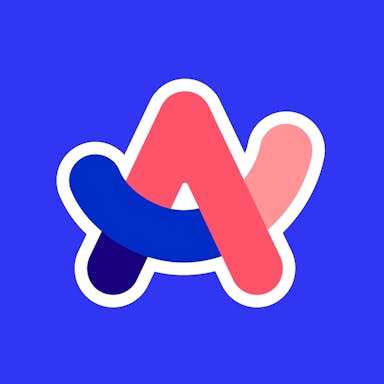Thesis
AI agents are autonomous software systems that perform web-based tasks without human intervention. The global AI agents market, valued at approximately $5.4 billion in 2024, is projected to grow to $50.3 billion by 2030, with some forecasts extending to $236 billion by 2034, implying a compound annual growth rate (CAGR) of ~45%. Despite this growth potential, only 2% of organizations have fully deployed agent systems, largely due to immature infrastructure and data readiness. As enterprises move from pilots to scale, the need for production-grade agent infrastructure is a critical bottleneck.
Browser-based automation is one possible enabling layer for this shift. Many enterprise workflows, from research and customer support to form submissions, are executed through web browsers. Traditional web scraping and brittle automation scripts struggle with dynamic JavaScript interfaces and login flows. Meanwhile, techniques like Retrieval Augmented Generation (RAG) and tools such as OpenAI Operator enable agents to fetch live data and execute browser navigation as part of task logic. As AI agents become more capable, “browser-as-a-service” infrastructure, which can reliably run, scale, and control real browsers, is crucial to operationalizing autonomous workflows.
Browserbase provides cloud-hosted headless browsers, or browsers dedicated to AI agents with no human-facing user interface. These browsers host features such as stealth mode, CAPTCHA handling, session logging, and autoscaling that are designed for agent workloads. Its open-source Stagehand SDK allows natural-language or code-driven orchestration of browser tasks, while the Director tool extends automation access to non-technical users, and MCP (Model Context Protocol) standardizes agent integration with browsing tools. As Paul Klein, the founder and CEO of Browserbase, summarized: “If you want AI to do the same work that you do on the web, you need to give it a browser.” Together, these capabilities position Browserbase as a key infrastructure layer for executing agentic automation at scale.
Founding Story
In January 2024, Paul Klein IV (CEO) founded Browserbase.
Klein is a software developer and serial entrepreneur, having worked at Twilio as a software engineer for three years before co-founding a live-streaming startup called Stream Club in 2020. Within a year, Stream Club was acquired by video platform Mux in late 2021.
At Mux, Klein spent two years working on headless browser technology to power large-scale live streaming, further honing his expertise in running web browsers in the cloud. He repeatedly encountered how painful it was to manage dozens of browser instances reliably. It was a “painful but necessary primitive,” as he later described it.
By late 2023, the rapid rise of generative AI introduced the question of how Klein’s colleagues could use browsers for automation. “After the 50th conversation, it became clear that there could be a product here,” Klein recalls. He realized no existing solution adequately gave AI agents access to web browsers at scale, and knowing he had the know-how to build it, he decided to create one himself, leading to the launch of Browserbase in early 2024, with a mission to provide cloud infrastructure for running thousands of headless browsers.
In Klein’s words, “I had the expertise, and the product I needed still didn’t exist – so I set out to build it with Browserbase.” He assembled a small founding team to bring this vision to life, recruiting early engineers like Dominic Saadi (joining as a founding engineer) and Walker Griggs, a previous colleague at Mux, as Browserbase’s technical lead.
Product
Browserbase offers browsers as a service. It’s a cloud-first platform that allows developers and AI applications to spin up thousands of fully managed Chromium instances through a simple API with no server handling required. At its core is a headless-browser runtime with built-in concurrency, observability, and stealth features, integrating seamlessly with web scraping libraries. Browserbase additionally offers Stagehand, an open-source SDK which translates natural language into browser actions, and Director, a no-code tool for orchestrating multi-step automation workflows. Browserbase also supports MCP (Model Context Protocol), a standardized bridge for LLMs like GPT‑4, Claude, and Gemini to interact with live web browsers, enabling coordinated control over multiple sessions in parallel.
Browserbase (Cloud Platform)
Browserbase offers a serverless developer platform to operate headless browsers. It lets developers and AI agents programmatically interact with websites without managing their own browser fleet.
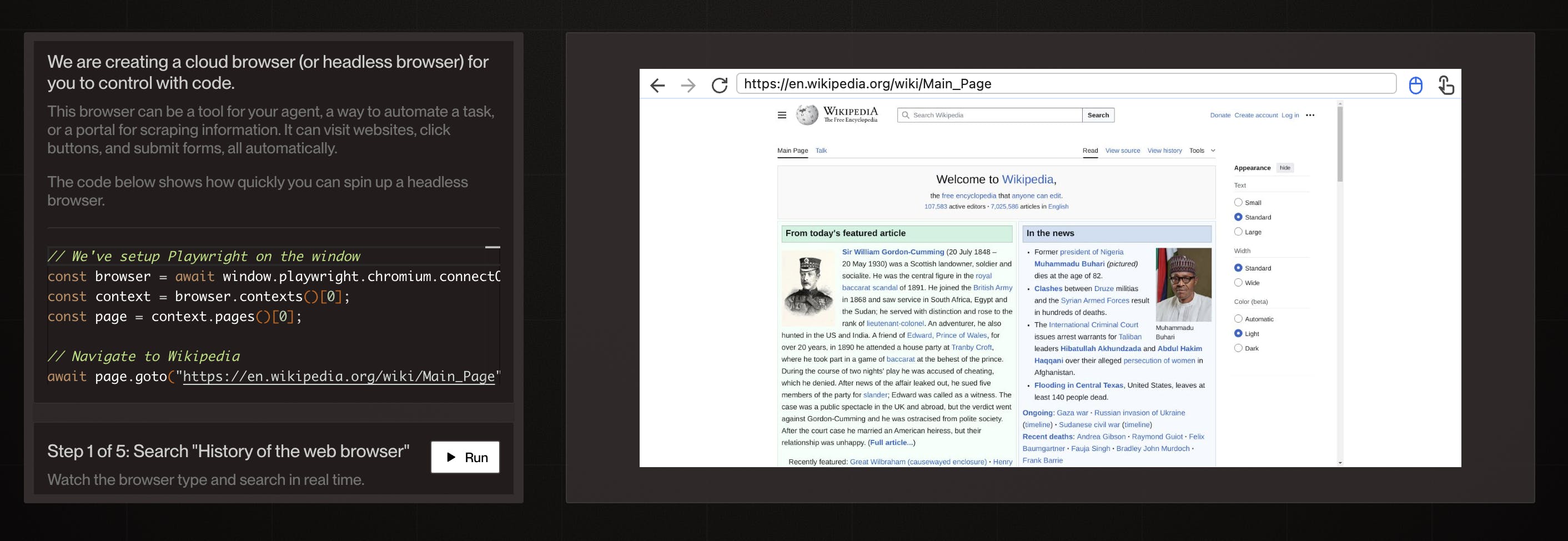
Source: Browserbase
As Browserbase describes it:
“A headless browser is a web browser controlled by code that uses software in the same way humans do: visiting sites, clicking buttons, and submitting forms, all automatically. It’s functionally identical to the web browser used on a machine, but it can run on a server. It’s “headless” because there is no graphical user interface (GUI), but it still loads and interacts with pages exactly like a regular web browser does.”
Browserbase provides an extensible platform with APIs to integrate a live browser view or retrieve logs and recordings. Additionally, Browserbase has native compatibility with web scraping libraries like Stagehand, Playwright, Puppeteer, Selenium and integrations with popular AI stacks, from crewAI to Langchain. Complete session visibility is also enabled through Session Inspector and Session Replay. As a result of Browserbase’s SOC-2 Type 1 and HIPAA compliance, solutions targeting healthcare and legal are applicable among the wider net of AI, GTM, tax, supply chain, and other applications.
Many customers use Browserbase to scrape data from websites for analytics or to feed into LLMs. For instance, gathering commodity price quotes from a foreign market website or scraping product info from legacy sites can be done by a Browserbase-driven bot instead of manual copy-paste. Unlike generic web scrapers, Browserbase can handle dynamic pages (JS, logins, etc.) because it’s a real browser.
AI assistants also integrate Browserbase to answer live web queries. An AI agent could browse a news site to fetch up-to-date information or log into an account to perform an action. For example, Browserbase enabled an AI agent to navigate Kalshi’s web interface and execute trades (selecting markets, placing a bet) just like a user would. This showcases how an LLM-based agent, given Browserbase, can take real actions online (beyond just retrieving text).
Customers are leveraging Browserbase to improve operational efficiency in traditional industries:
A solo developer used Browserbase to build an assistant that scraped gas prices from various websites to optimize trucking routes. This automated a task that was previously done manually by staff, saving time and money.
A dentist attempted to use Browserbase with AI to automate interacting with an insurance claims portal, highlighting demand outside the typical tech audience.
Some teams leverage Browserbase to run end-to-end tests or monitor web app performance. Because it can run many browsers in parallel and record sessions, it’s useful for automated QA or checking that websites are functioning.
Instead of manually managing headless Chrome instances (which can be unstable, resource-intensive, and hard to scale), developers plug into Browserbase’s high-performance browser cloud. Browserbase browsers can be launched in milliseconds and scaled to thousands of instances, thanks to a serverless architecture. Many workflows in business involve websites with no APIs or manual web data entry/extraction. Browserbase is used to automate these “messy parts of the internet” by letting an AI or script operate a browser just like a person would.
This is especially crucial in scenarios where building a custom integration is not feasible. Instead of hiring people to click through web portals or building ad-hoc scrapers, a developer can use Browserbase (and possibly Stagehand) to quickly automate the task. Klein noted that “tens of thousands of websites… aren’t going to ship a first-party AI integration anytime soon. That’s where we come in.”
Stagehand (Automation Platform)
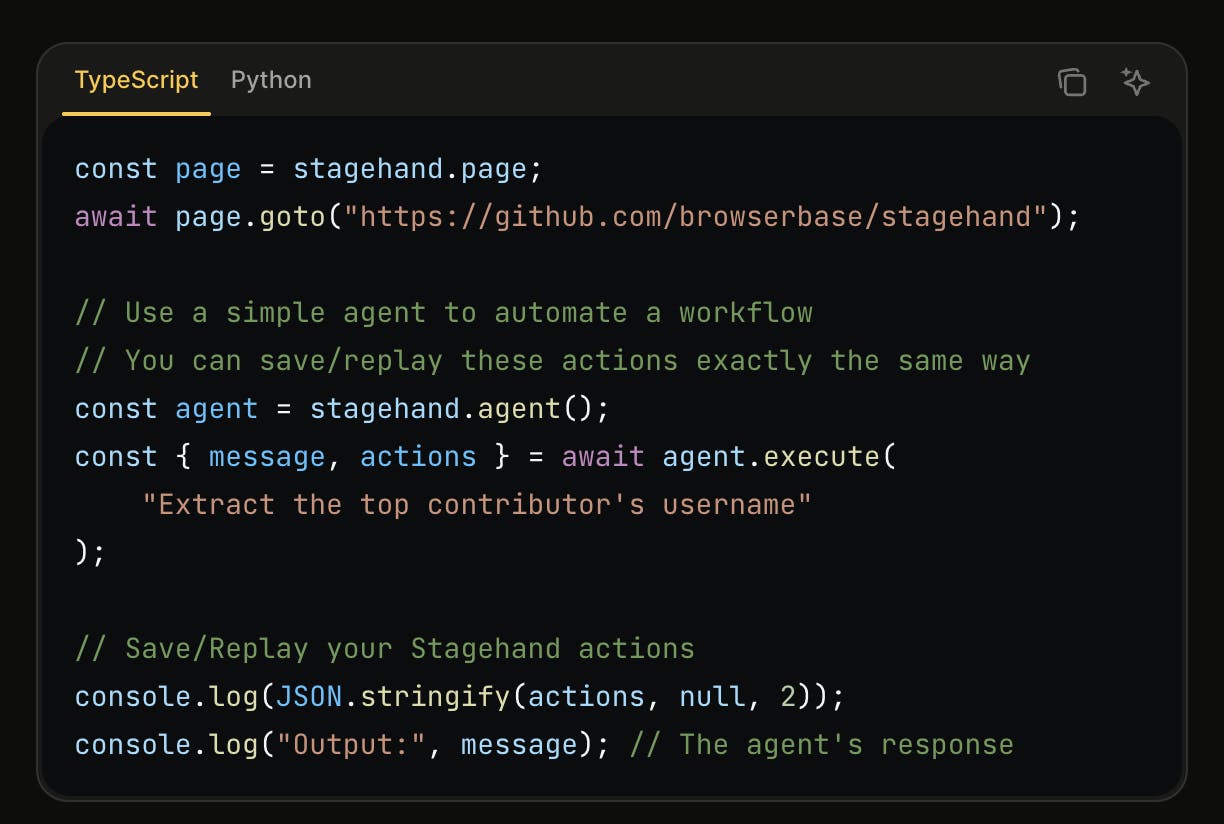
Source: Stagehand Docs
Stagehand is an open-source AI browser automation framework (SDK) that combines the precision of scripted automation with the flexibility of AI. It’s provided as a free open-source library (available on GitHub and installable via npm or pip) that can run locally or connect to Browserbase cloud browsers. Stagehand provides high-level agent capabilities alongside low-level control (via commands like “act”, “extra ct”, “observe”) for robust web automation.
Suppose an operations team needs to pull lead info from hundreds of company websites that each have a contact form. Using Stagehand, a developer can write an agent that goes to each site, fills out the form (with atomic actions for each field), and then extracts the resulting data, such as a contact email or pricing info. Traditional scripts might break if a form’s HTML changes slightly. Stagehand’s resilient approach adapts to minor changes, and its agent can even handle multi-step flows like confirmation pages.
Stagehand can also drive an agent that reads and compares web content. For example, a product manager could use Stagehand to automate reviewing documentation changes: the Stagehand agent might navigate to a documentation site, use AI to observe and compare the current content with a changelog or previous version, and then suggest updates or generate summaries.
Web scraping often fails when sites change structure. Stagehand shines in web crawling scenarios where ongoing data extraction is critical (e.g., monitoring competitor prices or aggregating news articles daily). A Stagehand script can crawl through multiple pages, and if an element it needs disappears or moves, the self-healing agent logic can kick in (even escalating to a full AI re-plan if needed.
Stagehand promises automations that continue working despite web changes and can handle complex, high-level tasks with minimal coding. This directly addresses the pain points of broken scripts and unpredictable AI behavior that many developers face.
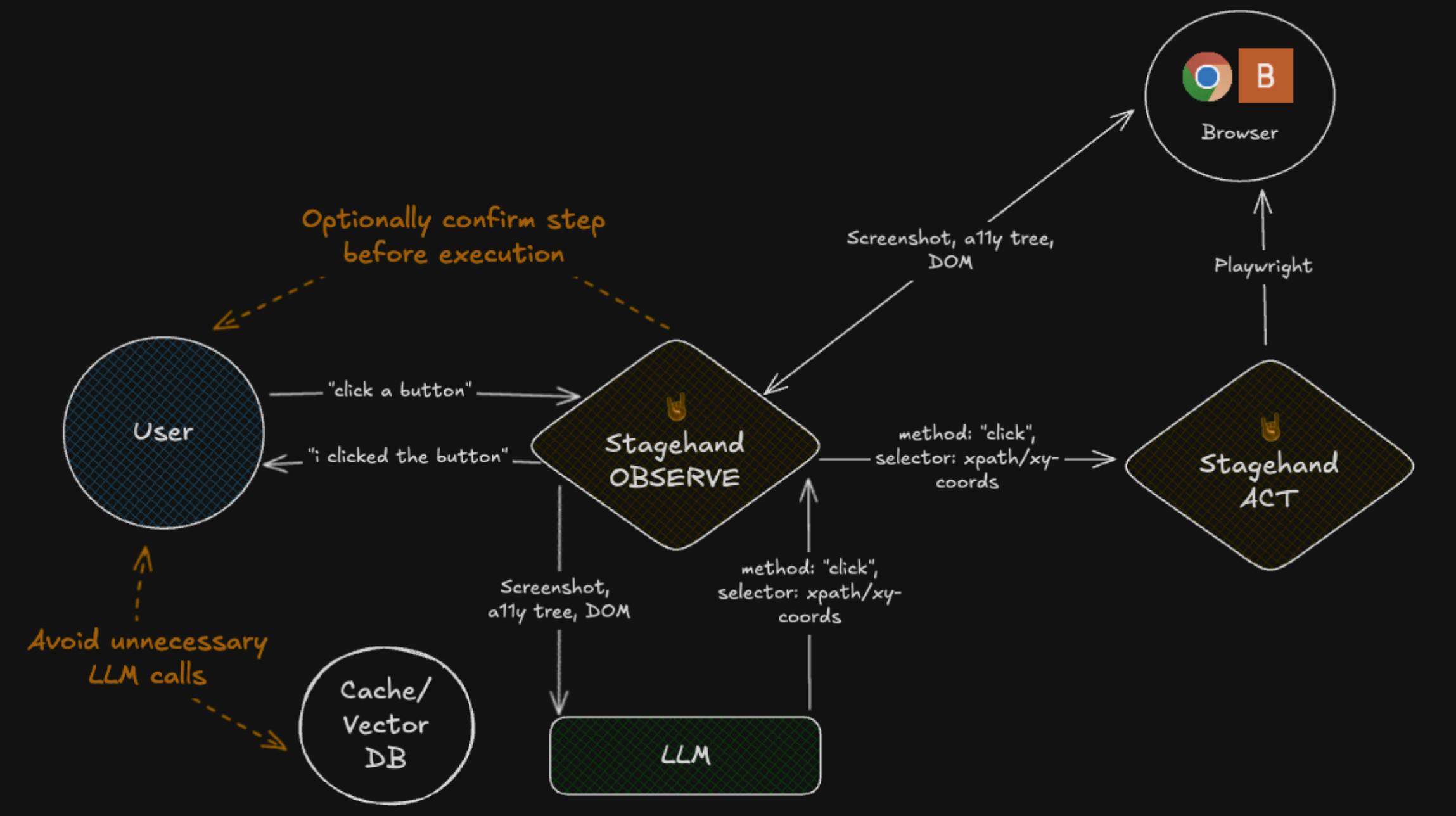
Source: Stagehand Docs
For a developer, Stagehand’s job is to reduce the time and effort to create a web automation script that won’t break and doesn’t require constant updates. It lets them focus on what needs to be done (the outcome) rather than the low-level how (exact selectors, etc.), because the AI guidance fills in those details.
For example, traditionally, a dev might spend hours writing a scraper for a site and then fixing it whenever the site updates. With Stagehand, they can write a more abstract script (“go to each product page and extract the price and rating”) and trust the framework to handle minor page changes or decisions, saving maintenance work.
For an AI agent, Stagehand’s job is to give the agent tool use skills, essentially teaching an AI to use a web browser in a controlled way. By providing the MCP interface and a structured approach to browser actions, Stagehand allows any LLM-based agent to perform multi-step web tasks. It deploys browser automations (research agent, task agent, or authenticated agent).
Stagehand’s API revolves around a few key functions: page.goto() to navigate, page.act() to perform an action (click, type, etc.) described in natural language, page.extract() to pull structured data from the page by describing what to get, and page.observe() to have the AI plan an action before execution. There is also an agent.execute() method that accepts a high-level instruction (prompt) and returns a sequence of actions (and an AI message) that accomplish it.
Under the hood, Stagehand uses large language models to interpret these instructions and map them to browser operations. It works with multiple LLMs: developers can configure it to use OpenAI’s GPT-4 or Anthropic’s Claude or others for different purposes. A key feature in Stagehand 2.0 is multidimensional self-healing. If an action fails (e.g., the selector isn’t found), Stagehand can try alternative strategies. At a basic level, it might rephrase the instruction or look up the Accessibility Tree differently. If that fails, Stagehand can escalate to using the agent(), essentially allowing the LLM to reassess the situation and come up with a new plan mid-execution.
A user starts using Stagehand locally with full feature compatibility, and when ready to deploy to production, they will need to connect to browsers running in the cloud.
Director (No-Code Builder)
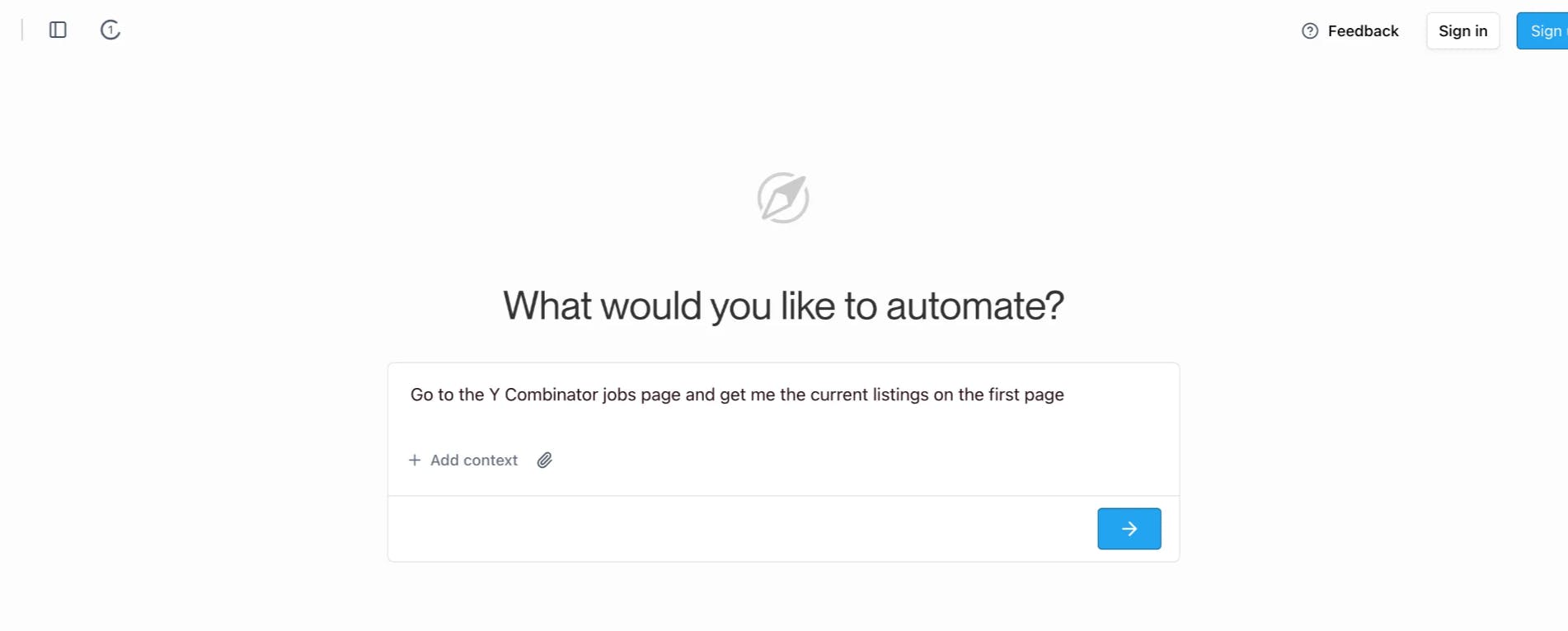
Source: Director
Director, launched in June 2025, is a web app aimed at non-developers (e.g., “vibe coders” in operations or analysis roles). It turns plain English instructions into executable browser workflows (Stagehand scripts) that run on the Browserbase platform.
Users “hire” Director to take a task description and return a functioning automation. For example, an HR coordinator might want to automatically check a government license verification site for dozens of employees. Their job-to-be-done is to verify licenses without manually going through each one. Using Director, they could just input: “Go to the state licensing website, search for Person X’s license number, and tell me if it’s active.” Director will then produce a workflow that navigates the site and checks the status. The user can run it for one person or adapt it for a list of names. Importantly, Director’s output being a Stagehand script means the job isn’t just done once. It’s a repeatable solution.

Source: Director
Director’s front-end is a prompt input where the user describes the task. This description is sent to an LLM to output a Stagehand script that accomplishes the task. The prompt engineering behind the scenes ensures the AI understands the user’s intent and translates it into the correct sequence of Stagehand commands (Stagehand’s DSL). For example, if the user says “click the green button labeled Submit,” the AI will produce something like page.act("click the green Submit button") in the script.
Every automation from Director runs on Browserbase’s infrastructure. This means Director benefits from Browserbase features like proxy management and live view without user direction. For example, if a Director-generated script encounters a CAPTCHA, Browserbase will handle it, or if it needs to run for a long time, Browserbase can keep the session alive. Director essentially acts as an intelligent front-end to configure Browserbase sessions through natural language.
With Director, users can simply describe a task in natural language like: “Go to the California nursing license database, search for Julia with license number #####, and tell me if her credential is active.” Marketers can automate data collection from competitor sites or posting updates, which turns a multi-click process into one automated job:
“Go to competitor.com, find the price of Product X and note it down.”
“Sign in to LinkedIn, navigate to our company page analytics, and extract the visitor stats.”
Individuals can also use Director for personal tasks, such as “Check my frequent flyer account and tell me my current miles” or “Find me available apartments on website Y with 2 bedrooms under $2000 and list them.” Director was highlighted as a tool for “vibe coders” who build small automations for personal or team use.
Director democratizes web automation and enables “everyone to automate the web”, not just programmers. No programming skills are required, so an operations manager or marketer can also use Director, lowering the skill barrier. As Klein said, “building a product for everybody — even people not familiar with programming — required us to rethink everything from the ground up.”
Browserbase MCP (Integration Tool)
Browserbase also offers an open protocol (with an open-source server implementation) that enables LLMs to use external tools like web browsers. Model Context Protocol (MCP) defines how a large language model can call functions, like controlling a browser, by treating those capabilities as part of its context.
Browserbase’s MCP server allows an AI agent (e.g. Anthropic’s Claude or OpenAI’s GPT-4) to navigate websites, fill forms, extract data, and more by calling Browserbase/Stagehand functions as tool APIs. The company open-sourced their MCP server in late 2024. It’s available on GitHub (browserbase/mcp-server-browserbase) and has two main components:
Core Browserbase actions (controlling the cloud browsers with commands like navigate, click, screenshot, etc.)
Stagehand actions (exposing Stagehand’s act, extract, etc., allowing more high-level instructions).
For developers building AI systems, MCP provides a ready-made interface to plug in Browserbase’s capabilities. Instead of writing custom code to connect an LLM to a browser automation script, a developer can use MCP and instantly get a suite of browser functions exposed to the AI. MCP being open means it encourages a tool ecosystem. It’s not a proprietary one-off integration.
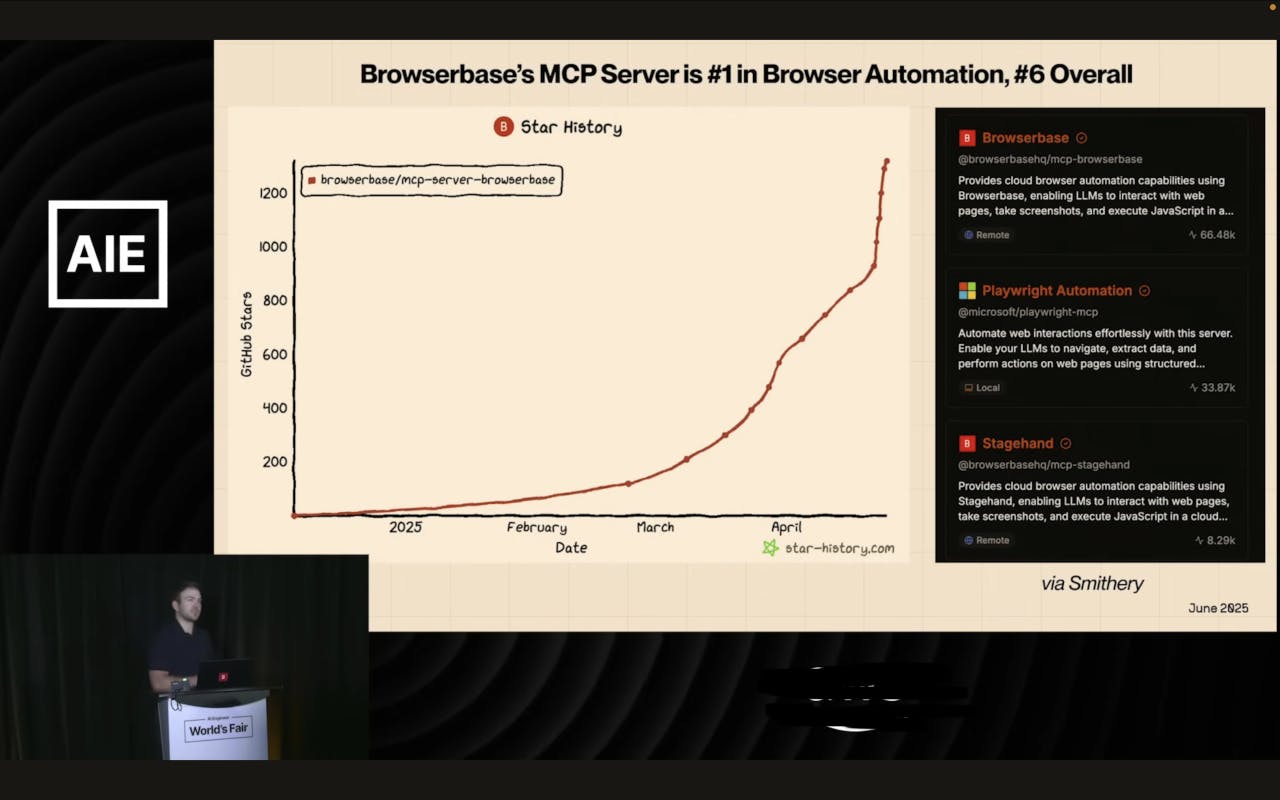
Source: AI Engineer, YouTube
Market
Customer
Browserbase primarily serves AI-focused software teams and developers who need to automate web interactions. This includes AI-first startups (leveraging LLMs to act on the web) as well as enterprise IT teams that need to script and automate actions in web applications.
There is indeed a D2C angle via Director; however, Browserbase ideally benefits from AI-focused software teams that make use of all product offerings. The product is developer-friendly and offered via self-service, making it relatively simple for the target users to try and buy.
The team did not hire their first salesperson until mid-2025, after over 50 million browser sessions, suggesting the product resonates with developers without requiring heavy traditional sales efforts. Browserbase’s customer base is comprised of over 1K paying customer organizations and more than 20K individual developers.
Before Browserbase, developers faced the tedious task of running headless browsers themselves, something Klein called a “painful but necessary primitive” in building software. Customers had a few suboptimal options:
DIY with open-source tools: engineering teams would script with Puppeteer/Playwright or Selenium and run headless Chrome on their own servers or Kubernetes clusters, which is labor-intensive to set up and hard to scale
Legacy headless browser services: using existing cloud providers like Browserless.io or others, which often have higher costs or limitations
Simply doing without automation: using human teams or foregoing certain data if automation was too difficult. For example, one startup (Pursuit) set up its own compute cluster to scrape government websites, only to find it “really sucks to run this ourselves,” and switched to Browserbase for a more efficient solution.
Individual developers have also noted cost benefits in switching. One user saved $160/month by cancelling a competitor (Browserless) and moving to Browserbase’s platform. Browserbase’s notable customers include Perplexity, Convergence, and Vercel as of August 2025.
Market Size
Browserbase operates within the web automation market and the emerging AI agent infrastructure category. It provides cloud-based “headless browser” infrastructure, which is a niche that historically was a backwater of developer tooling and often limited to web testing or scraping. Traditionally, headless browsers were mostly associated with web scraping tools, but Browserbase’s focus is broader: it enables full workflow automation via a browser.
In terms of industry classification, Browserbase competes in developer infrastructure/automation software, akin to cloud services for automation, overlapping with segments like web data extraction services and Robot Process Automation (RPA) platforms.
The potential customer base for Browserbase is substantial, given the ubiquity of web-based processes. Essentially, any organization that uses websites or web apps as part of its operations could benefit from automating those interactions. This spans tech companies and beyond. Moreover, the push for automation is widespread across enterprises: in a Deloitte global survey published in January 2025, 78% of companies reported they have already implemented RPA solutions or plan to do so shortly.
Given that Browserbase addresses automation needs specifically involving web browsers, which many traditional APIs or IT systems don’t cover, the service could attract a significant portion of these automation-minded organizations. Additionally, there are millions of software developers globally. Any team building an AI-driven app or needing to script web tasks is a potential user.
Pinpointing an exact TAM is challenging since Browserbase targets multiple markets. The web scraping/data extraction software market, one component of Browserbase’s domain, was estimated at roughly $1 billion in 2024 and is estimated to grow to $2.49 billion by 2032. Meanwhile, the broader automation software sector is much larger. For example, the robotic process automation (RPA) market (which includes automating repetitive tasks in enterprises) is projected to reach about $22 billion in 2025 and $211 billion by 2034.
In the near term, capturing the web-focused slice of the automation market is a significant opportunity. The global web scraping industry is growing ~14% annually and is expected to double (or more) by 2035.
Competition
Competitive Landscape
Browserbase operates in a market for AI-driven web automation, where competition comes from both startups and established players. The space is fragmented among developer-focused startups and a few larger automation platforms.
New startups like Hyperbrowser and Browserless offer similar “browser-as-a-service” infrastructure for AI agents, while incumbents in adjacent fields (e.g. RPA or web testing tools) are extending into this domain. The market is largely driven by startups innovating on headless browser tech for AI, since traditional browser automation was previously geared toward QA testing or basic web scraping. Incumbent testing platforms and RPA companies (e.g. BrowserStack, Sauce Labs, UiPath) have substantial user bases and resources, but their focus has been slightly different (QA and enterprise workflows) compared to Browserbase’s AI-agent-centric approach. Overall, competition ranges from highly-funded automation giants to bootstrapped niche providers.
Competitors
UiPath: UiPath, founded in 2005, is an enterprise RPA platform that went public in 2021, which has a market cap of $6.0 billion as of August 2025. Its software automates repetitive UI tasks across applications, including web browsers. UiPath’s platform offers a no-code/low-code interface geared toward business users, and it integrates AI/ML for smarter automation. Unlike Browserbase (which is developer-focused and provides raw browser sessions as infrastructure), UiPath provides a comprehensive automation suite for enterprises. Furthermore, UiPath’s scale (6.3K customers and $360 million revenue by 2020) and deep pockets make it a major indirect competitor in any automation-related market.
BrowserStack: BrowserStack, founded in 2011, is a cloud-based testing platform that enables developers to run browsers and devices for testing websites and apps. The company has raised $250 million, including a $200 million Series B led by BOND and Accel at a $1.4 billion valuation in 2021. BrowserStack built a large customer base (1K+ customers as of July 2025) by providing an easy way to test across many browser/OS combinations. Its Automate product (headless browser grid) overlaps with Browserbase’s infrastructure offering, as both allow spinning up browsers in the cloud. However, BrowserStack is primarily used for QA/testing scenarios, not explicitly for autonomous AI agents. While BrowserStack is an incumbent with significant resources and a related service, Browserbase differentiates itself by focusing on AI-driven use cases and offering higher-level automation tools.
Bright Data: Bright Data, founded in 2014, is a web data collection and proxy platform. It is a private, profitable company that was valued at $200 million in a 2017 buyout by EMK Capital. Bright Data has grown to $100 million in annual revenue as of 2021. The company provides residential proxies, web scraping tools, and added headless browser automation in its product suite. Like Browserbase, it tackles the challenge of accessing websites with bots, offering solutions for CAPTCHA solving, anti-bot evasion, and data extraction. It even has no-code scraping interfaces for non-dev users. Bright Data is more focused on data scraping and proxy services, whereas Browserbase offers a more developer-centric browser runtime environment. Bright Data’s scale and financial strength make it a significant competitor for customers who need both browsing and extensive proxy networks.
Sauce Labs: Sauce Labs, founded in 2008, is an automated testing cloud for web and mobile applications. It has raised over $150 million, including a $79.9 million Series G round in 2024. Sauce Labs allows developers to run Selenium, Playwright, or Appium tests on a cloud of browsers/devices, with enterprise features for reliability and security. This directly parallels Browserbase’s core infrastructure (scalable headless Chrome instances), though Sauce’s focus is QA and CI/CD use-cases. Its customers include large enterprises (e.g. Salesforce, Visa). As Browserbase moves beyond testing into broader web automation, its offerings overlap with Sauce’s. Sauce’s long experience with browser cloud architecture and features like real device testing are its primary differentiators from other players in the space.
Browserless: Browserless, founded in 2015, is a bootstrapped startup offering “headless browsers as a service” to developers. The company has raised little external funding (it participated in an accelerator) and grew organically, reportedly reaching about $600k annual revenue by 2023. Browserless’s feature set (headless Chrome with an API, built-in proxy and CAPTCHA solutions, etc.) is very similar to Browserbase’s core infrastructure. Browserless was one of the earlier developer-focused services in this niche, popular for web scraping and automation tasks. Browserless offers a reliable browser cloud, but without the broader product ecosystem. Browserbase, in contrast, is venture-backed and building additional layers (framework SDK, natural language automation) on top of the browser infrastructure. Browserless also tends to be geared toward scrapers and QA developers on a smaller scale; Its largest plan supports 50 concurrent browsers as of August 2025.
Hyperbrowser: Hyperbrowser, founded in 2021, is a Y Combinator-backed startup that, much like Browserbase, provides scalable headless browsers for AI and web automation. Hyperbrowser describes itself as “AI’s gateway to the web,” offering an API to spin up browser sessions with stealth mode, proxy rotation, automatic CAPTCHA solving, and support for thousands of concurrent browsers. The product emphasizes fast (<1s) startup times and undetectable automation, directly targeting the same AI agent use-cases as Browserbase. It is a direct competitor in nearly every sense: both Hyperbrowser and Browserbase aim to be the go-to cloud infrastructure for agents that need to browse websites. Browserbase currently has a larger customer base and additional features like the Director no-code tool. As of July 2025, Hyperbrowser is one of Browserbase’s closest like-for-like competitors.
Business Model
Browserbase offers a freemium and usage-based SaaS model.
All products feed into a single revenue model (the cloud browser platform), while each product plays a distinct role:
Browserbase: The primary income source, charging subscription fees and per-hour usage for running headless browsers in the cloud.
Stagehand: Free for developers. Stagehand is released under an open-source license, lowering the barrier for developers to write automation scripts. This drives demand for the cloud service as developers write scripts with Stagehand and run them at scale on Browserbase’s paid infrastructure.
Director: Free. There is no separate fee for Director. This funnels a broader user base (operations teams, analysts, etc.) into the usage-based cloud platform. In essence, Director expands the market to new users who will generate usage revenue on the core Browserbase service.
MCP: Free. It’s available on GitHub (Apache-2.0 license) with thousands of developers showing interest. MCP itself is not a paid product, part of the ecosystem to encourage integration of Browserbase into AI agent applications, indirectly driving cloud usage.
Browserbase Product Pricing Tiers
In the cloud, Browserbase provides usage-based pricing and the ability to instantly spin up browsers in multiple regions.
Scale Plan: custom rates for startups with unique needs, including HIPAA compliance and 250+ concurrent browsers.
Browserbase doesn’t manufacture hardware or own data centers outright, as it leverages cloud providers to run its service, outsourcing the capital expenditure. However, it is operations-heavy because the service requires significant computing power and bandwidth. Every customer browser session consumes server time and network resources, meaning variable costs remain high relative to a pure software company. In other words, Browserbase’s model resembles other cloud infrastructure platforms: it avoids large upfront capital investments, but must carefully manage usage costs and scale efficiently to maintain healthy margins.
Traction
Since its founding in early 2024, Browserbase has grown its team from three founding members to 30 employees by mid-2025. In 2025, the platform executed more than 50 million browser sessions, double the 25 million sessions recorded in 2024.
Browserbase serves 1K+ companies as of June 2025, and 20K+ developers have signed up. The usage drives 1.3 million downloads of Browserbase-backed tools per month on GitHub as of July 2024.
The June 2025 launch of Director marked the company’s expansion into non-developer segments and signals increasing traction across both developer and non-technical users.
Valuation
Browserbase raised a $40 million Series B in June 2025, led by Notable Capital with participation from existing investors CRV and Kleiner Perkins. This round was raised at a total valuation of $300 million, nearly 4x the valuation of its $21 million Series A raised in October 2024.
Browserbase has raised $67.5 million over three rounds as of July 2025. Earlier backers include CRV and angels Jeff Lawson (co-founder and ex-CEO of Twilio), Guillermo Rauch (CEO of Vercel), and Patrick Collison (founder and CEO of Stripe).
Key Opportunities
Growth of AI Agents
The rise of LLMs and AI agent applications is enabling a broader swath of web-based activities to be automated. AI systems are increasingly expected to perform tasks via the web, from querying websites to executing online transactions, without human intervention. For example, the number of developer applications leveraging Playwright, a popular headless browser framework, grew nearly fivefold in 2024 alone. Tech leaders like Andrej Karpathy have even proposed an LLM Operating System concept where the browser acts as the “eyes and ears” of AI agents in the world.
This trend is widely seen in tech circles (e.g. Hacker News discussions around Browserbase’s open-source tools) and by investors as a transformative shift in software. This AI-driven automation wave is a Twilio 2FA moment for automated browsing tools: a chance to become the infrastructure “rails” for a new era of applications.
Democratizing Web Automation with AI and No-Code Tools
As of August 2025, broad democratization of automation is underway, as advances in AI and low-code platforms make it possible for non-developers to automate tasks. Industry analysts note that low-code and no-code platforms are making RPA accessible to non-technical users, allowing even small businesses to leverage automation without extensive IT resources. In practice, this means employees can create bots or workflows via natural language or intuitive interfaces instead of writing complex code. The surge of interest in tools like ChatGPT and generative AI for workflow assistance has primed users to expect natural-language-driven automation.
Browserbase’s open-source Stagehand SDK was highlighted as a framework that “bridges the gap between AI language models and web browser control,” offering a simple natural language interface instead of brittle scripts. Overall, the market is embracing solutions that let “everyone be a developer” in the era of AI, effectively broadening the user base for web automation beyond just software engineers.
Browserbase can capitalize on this trend by positioning its products as the easiest way for anyone to automate the web. Its launch of Director.ai, a no-code browser workflow builder, was a major step in this direction. This opens up a vastly larger market: businesses and teams without dedicated developers can still automate routine web tasks, accelerating Browserbase’s adoption.
Unlocking Legacy Systems and Enterprise Workflows
Large enterprises and legacy systems present a ripe frontier for automation. Many organizations still rely on internal web applications or old SaaS tools that lack modern APIs or integrations. Developers in enterprises are often expected to automate these legacy systems, yet traditional tools fall short when no API is available. This reality is driving enterprises toward browser-based automation as a last resort to integrate legacy software, essentially having a headless browser act as a human user.
Industry-wide, the push for digital transformation and hyperautomation is stronger than ever, with the global RPA market estimated at $3.8 billion in 2024 and projected to reach $30.9 billion by 2030. This growth isn’t limited to tech-centric processes, as RPA and web automation are expanding into domains like healthcare, finance, and government, where legacy systems are common. However, enterprises also demand strict compliance, security, and reliability from any automation solution. Browserbase has also invested in enterprise-grade features, from achieving SOC-2 and HIPAA compliance for data security to offering an on-premises deployment option so that companies can run Browserbase behind their firewall.
Browserbase aims to provide the automation bridge for legacy and enterprise systems. By enabling web-based automation “as if [developers] were interacting in a browser,” even for outdated apps, it offers a path to integrate and streamline workflows without waiting for new APIs or expensive software overhauls.
Key Risks
Reliability & Scalability Bottlenecks
Browserbase markets the ability to “spin up thousands of browsers in a fraction of a second” to serve AI agents at massive concurrency. If infrastructure, networking, or session-isolation breaks under real-world load, customers’ bots crash and their trust in the platform may erode.
Early-stage outages are already visible. Public status logs show multi-hour downtime on June 12 (3h 5min) and another incident on June 26 (55min) that took the dashboard offline. Frequent interruptions threaten SLAs for enterprise users who embed Browserbase in production workflows. Most sessions are orchestrated on AWS or GCP, so any spike in egress prices, regional outage, or stricter browser-sandbox policies could balloon COGS or knock the service offline.
Web Scraping Ethics & Legal Uncertainty
Although Browserbase positions itself as “AI-agent infrastructure,” customers openly say large-scale scraping is a primary reason they pay for it. “Scraping is definitely a controversial thing,” Klein has said. Industry observers warn that a “wider debate about what fair use entails is looming,” and even sympathetic publishers dislike having their sites harvested without attribution.
At Browserbase, Klein says his company currently vets every at-scale customer’s use case for his software to see if it meets its guidelines. Browserbase has never received a complaint or takedown request, he claims.
GDPR, the UK’s Online Safety Act, and U.S. state privacy laws all place limits on the automated collection of personally identifiable information. A single precedent-setting lawsuit (similar to LinkedIn v. hiQ) could force Browserbase to gate, or outright ban, certain customer workloads.
Summary
Browserbase is an infrastructure startup offering a cloud platform for running headless web browsers at scale, enabling software, especially AI-driven agents and applications, to interact with websites in an automated way, e.g. clicking buttons, filling forms, or scraping data.
The company has gained traction with over 1,000 customer organizations, from AI-native startups (e.g. Perplexity, Vercel, Commure) to larger enterprises, and more than 20,000 developers, collectively running >50 million automated browsing sessions on the platform in 2025 alone. Despite only launching in early 2024, the company has reportedly reached around $3 million in revenue within its first 16 months, driven by usage-based pricing and growing adoption among teams expanding their automation workloads.
Competition and differentiation are key concerns: the core technology, orchestrating headless browsers, is not unique to Browserbase and even has open-source components, meaning other startups or in-house teams can (and do) run similar solutions on their own infrastructure. There are few inherent switching costs for customers, and even large AI platforms (which Browserbase doesn’t consider direct competitors yet) could develop comparable browser-automation capabilities in the future.
While Browserbase has established a strong early position in enabling web-for-AI automation, its long-term trajectory will depend on navigating competitive pressures, staying on the right side of emerging data-use policies, and capitalizing on (or withstanding) the true pace of the AI-agent market’s evolution.

